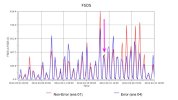Hello,
I am running an ensemble of single point simulations and try to force them with local observations from the FLUXNET dataset with CLM5 (starting as I2000Clm50BgcCropGs but modified the atm. forcing variables).
To generate the ensemble I perturb sand and clay fraction in the surface files and air temperature, precipitation, short- and long-wave radiation in the forcings.
When I use this perturbation method with reanalysis data (e.g. COSMO REA6) as forcing, I can run an ensemble of 100 members without issues.
However, when I start using the local FLUXNET data, some members run at different times into different errors.
The errors I have noticed the most are:
- "Negative conc. in ch4tran."
- "ERROR: Methane demands exceed methane available. ERROR in ch4mod.F90 at line 3408"
- "ERROR: ERROR in CNBalanceCheckMod.F90 at line 219"
Through a process of elimination I have determined that the errors only occur once the local shortwave radiation is included in the forcings.
All the other variables do not cause errors.
However, I can not find a reasonable explanation why the shortwave radiation inputs would cause these errors for some ensemble members but not others.
I checked for missing / incorrect values or for extremes at the time the error occurs.
For example in the following plot, I marked the date, where the error occurs (for the blue line) with a pink arrow and clearly the difference to the ensemble member where no error occurs (red line) is much larger for other dates where no error occurs.

So, now I wanted to ask, if anyone here has experience with custom forcings, specifically with custom shortwave radiation input and knows what exactly in these inputs causes these kinds of balance errors.
Is there a pre-processing step I can perform that can detect / correct the shortwave radiation data that causes these errors?
Or do I have to manually perturb the specific input files for each ensemble member with an error until they also run through without balance errors?
Thanks for any advice,
Best regards,
Lukas
I am running an ensemble of single point simulations and try to force them with local observations from the FLUXNET dataset with CLM5 (starting as I2000Clm50BgcCropGs but modified the atm. forcing variables).
To generate the ensemble I perturb sand and clay fraction in the surface files and air temperature, precipitation, short- and long-wave radiation in the forcings.
When I use this perturbation method with reanalysis data (e.g. COSMO REA6) as forcing, I can run an ensemble of 100 members without issues.
However, when I start using the local FLUXNET data, some members run at different times into different errors.
The errors I have noticed the most are:
- "Negative conc. in ch4tran."
- "ERROR: Methane demands exceed methane available. ERROR in ch4mod.F90 at line 3408"
- "ERROR: ERROR in CNBalanceCheckMod.F90 at line 219"
Through a process of elimination I have determined that the errors only occur once the local shortwave radiation is included in the forcings.
All the other variables do not cause errors.
However, I can not find a reasonable explanation why the shortwave radiation inputs would cause these errors for some ensemble members but not others.
I checked for missing / incorrect values or for extremes at the time the error occurs.
For example in the following plot, I marked the date, where the error occurs (for the blue line) with a pink arrow and clearly the difference to the ensemble member where no error occurs (red line) is much larger for other dates where no error occurs.

So, now I wanted to ask, if anyone here has experience with custom forcings, specifically with custom shortwave radiation input and knows what exactly in these inputs causes these kinds of balance errors.
Is there a pre-processing step I can perform that can detect / correct the shortwave radiation data that causes these errors?
Or do I have to manually perturb the specific input files for each ensemble member with an error until they also run through without balance errors?
Thanks for any advice,
Best regards,
Lukas
